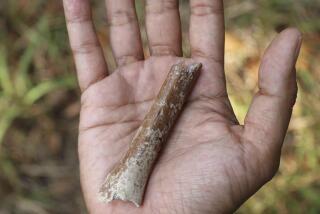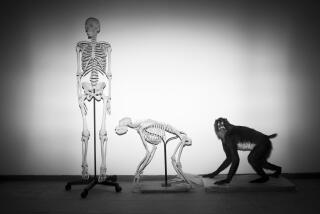Fossils May Be First Bilaterals
- Share via
At a quarry in southern China, researchers have discovered the oldest known ancestor of all creatures that have a left and a right, a front and a back, a top and a bottom.
A team of paleontologists from USC, Caltech and the Nanjing Institute of Geology and Paleontology in China found fossils of a 580-million-year-old microscopic creature believed to be the earliest known example of a bilateral body form -- an animal with a complex, purposeful shape, unlike the animated blobs that preceded it.
The specimens could be souvenirs from the start of one of life’s most successful experiments, when creatures first developed the anatomical symmetry that defines almost all modern life forms, including humans, experts at UC Berkeley and Dartmouth College said.
“It is the dream fossil, in a way,” said Duke University evolutionary biologist Gregory Wray.
A team led by Jun-Yuan Chen at the Nanjing Institute sorted through thousands of microfossils excavated at a calcium phosphate fertilizer pit to find the 10 specimens.
Each oval-shaped microfossil is no more than the width of four human hairs laid side by side, yet is surprisingly complex, the researchers said in work published online this week by Science Express.
The animal -- officially named Vernanimalcula guizhouena -- appears to be oriented along a line of orderly body parts, with a mouth in front and an anus at its rear, in contrast to the formless sponges and jellies that were its neighbors on the shallow floor of a primeval ocean.
The symmetrical anatomy of V. guizhouena suggests that the creature could direct its own movements, either in pursuit of prey or to flee larger predators, rather than drifting on currents or clinging to a rock, said USC earth sciences researcher David Bottjer, one of the study’s lead scientists.
“This is evolution on a very grand scale,” Bottjer said.






